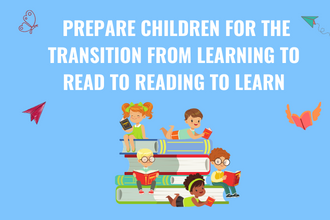Embracing Diversity: 6 Ways to Welcome Students Back to an Inclusive Classroom
Learn six impactful ways to welcome students back to an inclusive classroom. Discover personalized greetings, diverse decor, culturally responsive curriculum, community-building activities, inclusive language, and year-round diversity celebrations. Foster a sense of belonging and celebrate diversity every day.
Carving Moments, Cultivating Minds: Making Time for Reading in the Classroom and at Home
Discover how dedicated reading time in classrooms and at home fosters literacy, creativity, and a lifelong love for books. Learn tips for creating inviting reading spaces, integrating reading into various subjects, and empowering students with choice. Engage with literacy specialists to enhance home libraries and family reading rituals.
Navigating High/Low Books: Strategies for Comprehensive Understanding
Discover effective strategies to enhance comprehension of high/low books. Learn pre-reading activities, during reading techniques, interactive methods, and post-reading reflections to support diverse learners. Ensure every reader enjoys a rewarding literary journey.
Do you have enough books aligned to your ELA curriculum?
Discover how to evaluate and enhance the alignment of your classroom library with your ELA curriculum. Learn about scope and sequence, standards alignment, diversity, genre variety, readability, and more to support robust literacy instruction.
Building Bright Futures: Five Reasons to Help Students Create At-Home Libraries (And How to Do It)
Discover why creating at-home libraries for students is crucial for fostering a love for reading, promoting independent learning, and more. Learn practical tips and strategies to build personalized book collections that inspire young readers.
Balancing Decodable and Leveled Texts
Discover Dr. Bethanie C. Pletcher's insights on integrating decodable and leveled texts to enhance decoding skills and foster a love for reading in children. Learn practical strategies for balanced literacy.
Celebrating Identity in Stories
Recognizing the significant impact that books have, particularly in the initial steps of a young learner's adventures in literature is important. As we navigate this blog, we’ll delve into why it is not just beneficial but crucial for students to encounter characters that mirror the diverse tapestry of their identities and experiences.
Bridging the Literacy Gap: The Importance of High/Low Books in Helping Readers Finish Their First “Real Book”
Finishing a "real book" is a milestone in a student’s life. For struggling or reluctant readers, high/low books stand as invaluable markers, offering a bridge between accessibility and engaging content, giving them a taste of success and helping to grow their reading stamina. We frequently hear from students that our high/low books are the first “real book” they’ve ever finished, helping them begin to identify as readers. Today we'll explore the significance of high/low books in helping readers finish their first "real book" and the transformative impact this experience can have on their reading journey.
What Comes After Decodables? High/Low Books as a Resource
As educators and curriculum specialists, we understand the importance of providing students with the right tools to foster their reading development. Decodable books have long been a staple in literacy instruction, offering early readers the opportunity to practice phonics skills in context. But what comes next after mastering phonics? Enter high/low books—a valuable resource that bridges the gap between decoding and comprehension, offering a multitude of benefits for students at various reading levels.
How Can Technology Be Effectively Integrated Into Early Literacy Instruction?
Technology can be a valuable tool when effectively integrated into early literacy instruction. Here are ways to use technology to support and enhance early literacy skills:
Ensure a Strong Start for Young Readers
The early stages of literacy development are crucial for young readers. They help young learners develop foundational skills for their success as young readers and lifelong learners.
Different Kinds of Literacy: A Dive into Informational, Content, and Functional Literacy
Literacy is a critical part of education, supporting students’ ability to navigate various types of texts and contexts effectively. Let’s explore four key types of literacy: informational, content, and functional literacy.
What Strategies Are Effective for Supporting Struggling Readers in the Early Stages of Literacy Development?
Supporting struggling readers in the early stages of literacy development requires targeted and differentiated strategies. Here are effective strategies for helping struggling readers in the early stages:
The Role of Parents in Supporting Early Literacy Development
Parents play a crucial role in supporting early literacy development. Here are ways parents can actively engage with their child's early literacy development.
What Elements Contribute to Creating a Literacy-Rich Environment in Both Classrooms and Homes?
Creating a literacy-rich environment in classrooms and homes is crucial for supporting overall literacy development. Here are some key elements that contribute to a literacy-rich environment:
How Can Parents Support Early Literacy Instruction At Home?
Parents play a crucial role in supporting early literacy instruction at home. Here are 9 ways parents can contribute to their child's literacy development.
The Art of Active Listening: Building Vocabulary Skills
In this blog post, we'll delve into the art of active listening and explore strategies to cultivate vocabulary skills through attentive engagement with spoken language
How Should Instructors Move From Balanced Literacy to the Science of Reading?
In this blog, we look at the steps that instructors can consider when transitioning from balanced literacy to the science of reading.
How Do Early Literacy Programs Prepare Children for the Transition From Learning to Read to Reading to Learn?
Early literacy programs play a crucial role in preparing children for the transition from learning to read to reading to learn.
Unveiling the Magic: 8 Ways to Use Decodable Books in the Classroom
Decodable books play a pivotal role in early literacy education, providing a solid foundation for young readers. Here are eight creative ways to maximize the use of decodable books in the classroom and cultivate a love for reading.




















